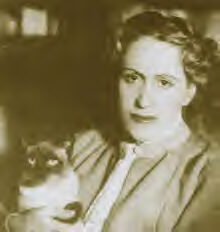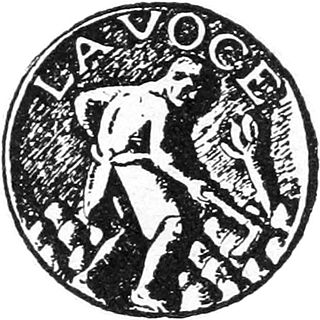Related Research Articles

Giuseppe Ungaretti was an Italian modernist poet, journalist, essayist, critic, academic, and recipient of the inaugural 1970 Neustadt International Prize for Literature. A leading representative of the experimental trend known as Ermetismo ("Hermeticism"), he was one of the most prominent contributors to 20th century Italian literature. Influenced by symbolism, he was briefly aligned with futurism. Like many futurists, he took an irredentist position during World War I. Ungaretti debuted as a poet while fighting in the trenches, publishing one of his best-known pieces, L'allegria.

Eugenio Montale was an Italian poet, prose writer, editor and translator, and recipient of the 1975 Nobel Prize in Literature.

Elio Vittorini was an Italian writer and novelist. He was a contemporary of Cesare Pavese and an influential voice in the modernist school of novel writing. His best-known work, in English speaking countries, is the anti-fascist novel Conversations in Sicily, for which he was jailed when it was published in 1941. The first U.S. edition of the novel, published in 1949, included an introduction from Ernest Hemingway, whose style influenced Vittorini and that novel in particular.

Conversazione in Sicilia is a novel by the Italian author Elio Vittorini. It originally appeared in serial form in the literary magazine Letteratura in 1938–1939, and was first published in book form under the title Nome e Lagrime in 1941. The story concerns Silvestro Ferrauto and his return to Sicily after a long absence. Major themes of the work are detachment, poverty, exploitation and marital fidelity and respect.

Salvatore Quasimodo was an Italian poet and translator, awarded the 1959 Nobel Prize in Literature "for his lyrical poetry, which with classical fire expresses the tragic experience of life in our own times". Along with Giuseppe Ungaretti and Eugenio Montale, he was one of the foremost Italian poets of the 20th century.

Caffè Giubbe Rosse is a historical literary café in Piazza della Repubblica, Florence. When opened in 1896, the cafè was actually called "Fratelli Reininghaus". It was named "Giubbe Rosse" in 1910, after the red jackets which waiters used to wear every day.

Vasco Pratolini was an Italian writer of the 20th century. He was nominated for the Nobel Prize in Literature three times.

Gianna Manzini was an Italian writer whose Ritratto in piedi won her the Premio Campiello in 1971. It is a semi-autobiographical portrait of her father, an Italian anarchist. After several banishments for his political activities, her anarchist father was exiled to the small hilltop town of Cutigliano in 1921, 25 km northwest of Pistoia, where he died of a heart attack in 1925 after being chased by fascist hoodlums.
Fabio Vittorini is an Italian literary critic, currently Professor of Comparative Literature at IULM University of Milan (Italy) He is known for his studies on opera and on metamodern narratives. He is the author of many books and articles.
Hermeticism in poetry, or hermetic poetry, is a form of obscure and difficult poetry, as of the Symbolist school, wherein the language and imagery are subjective, and where the suggestive power of the sound of words is as important as their meaning. The name alludes to the mythical Hermes Trismegistus.

La Voce was an Italian weekly literary magazine which was published in Florence, Italy, between 1908 and 1916. The magazine is also one of the publications which contributed to the cultural basis of the early forms of Fascism. It also contributed to the development of the concept of Europeanism.
Il Politecnico was a Communist cultural and literary magazine published in Milan, Italy, between 1945 and 1947. In the debut editorial it was stated that the magazine was inspired by the homonymous journal which had been founded by Carlo Cattaneo in 1839 and published until 1845. Although it was a short-lived publication, Il Politecnico was the most prominent magazine in Italy during its run.
Circoli was a bimonthly literary magazine published in Genoa, Italy, between 1931 and 1936. It was described as one of the most distinguished European magazines in 1934.

Alfredo Vernacotola was an Italian poet and writer.
Il Frontespizio was an Italian art and literary magazine, which had a Catholic perspective. The magazine existed between 1929 and 1940 and was based in Florence, Italy.

Alessandro Bonsanti was a writer and Italian politician.
Enrico Falqui was an Italian writer and literary critic.
Omnibus was a weekly illustrated general cultural magazine published in Milan, Italy, between 1937 and 1939. Its subtitle was settimanale di attualità politica e letteraria. It is described as the "father of Italian magazines", especially in regard to the use of photographs and images. The magazine was closed by the fascist authorities.

La Ronda was a literary magazine which existed in Rome, Kingdom of Italy, between April 1919 and November 1922. In December 1923 a special issue was also published.
References
- 1 2 3 4 5 6 Ann Caesar; Michael Caesar (2007). Modern Italian Literature. Cambridge: Polity. p. 175. ISBN 978-0-7456-2799-1.
- ↑ Sergio J. Pacifici (1955). "Current Italian Literary Periodicals: A Descriptive Checklist". Books Abroad. 29 (4): 409–412. doi:10.2307/40094752. JSTOR 40094752.
- ↑ Daria Ricchi (2021). "'Andare verso il popolo (Moving Towards the People)': Classicism and Rural Architecture at the 1936 VI Italian Triennale". Architectural Histories . 9 (1). doi: 10.5334/ah.451 .
- 1 2 Carmine Paolino (January 1980). La Narrativa di Alessandro Bonsanti (PhD thesis). University of Connecticut.
- ↑ Lorenzo Salvagni (2013). In the Garden of Letters: Marguerite Caetani and the International Literary Review Botteghe Oscure (PhD thesis). University of North Carolina at Chapel Hill. doi:10.17615/qxd3-0x37.
- 1 2 Vanessa Santoro (2019). Fashioning sensibility: emotions in Gianna Manzini's fashion journalism (MA thesis). University of Glasgow. p. 21.
- 1 2 3 Mathijs Duyck (2015). "The Modernist Short Story in Italy" (PDF). University of Ghent. Retrieved 8 January 2017.
- ↑ Remo Cesarani; Pierluigi Pellini (2003). "The Belated Development of a Theory of Novel in Italian Literary Culture". In Peter Bondanella; Andrea Ciccarelli (eds.). The Cambridge Companion to the Italian Novel. Cambridge, UK: Cambridge University Press. p. 7. ISBN 978-0-521-66962-7.
- 1 2 Ernesto Livorni (Winter 2009). "The Giubbe Rosse Café in Florence. A Literary and Political Alcove from Futurism to Anti-Fascist Resistance". Italica. 86 (4): 604. JSTOR 20750654.
- ↑ Gaetana Marrone, ed. (2007). Encyclopedia of Italian Literary Studies: A-J. New York; London: Routledge. p. 1898. ISBN 978-1-57958-390-3.
- 1 2 Eric Jon Bulson (2016). Little Magazine, World Form. New York: Columbia University Press. pp. 120–121. doi:10.7312/buls17976. ISBN 9780231542326.
- ↑ Tiffany J. Nesbit (31 October 2007). "Cafe' society: The Giubbe Rosse". The Florentine. No. 66. Retrieved 8 January 2017.
- ↑ Maria Belén Hernández-González (2016). "The Construction of the Memory of Italy in Argentina through a Choice of Translated Essays". CALL: Irish Journal for Culture, Arts, Literature and Language. 1 (1). doi:10.21427/D7V88R.
- 1 2 Roberto Ludovico (2013). "Renato Poggioli. Between History and Literature". Studi Slavistici: 301–310. doi:10.13128/Studi_Slavis-14150.
- ↑ Jane Dunnett (2002). "Foreign Literature in Fascist Italy: Circulation and Censorship". TTR: Traduction, terminologie, rédaction. 15 (2): 97–123. doi: 10.7202/007480AR .
- ↑ Livio Loi (October 2015). "Fame or Freedom? 'Resistance' to Fame and the search for Happiness of Italian modern poet Sandro Penna" (PDF). International Journal of Arts and Commerce. 4 (8). ISSN 1929-7106.
- ↑ Lynn M. Gunzberg (1992). Strangers at Home: Jews in the Italian Literary Imagination . Berkeley, CA: University of California Press. p. 244. ISBN 978-0-520-91258-8.
- ↑ Christopher Rundle (2000). "The Censorship of Translation in Fascist Italy". The Translator. Studies in Intercultural Communication. 6 (1): 67–86. doi:10.1080/13556509.2000.10799056. hdl: 11585/877981 . S2CID 143704043.